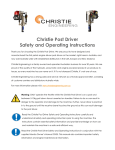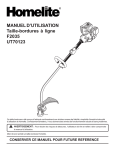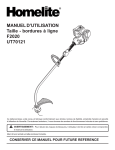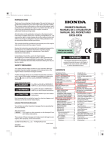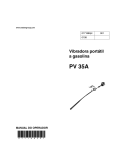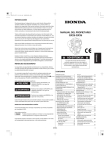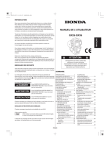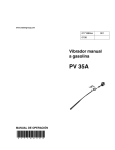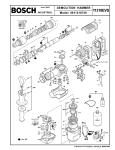Download Petrol post driver Safety and Operating Instructions
Transcript
Petrol post driver Safety and Operating Instructions Warning: Do not operate throttle while the tool is not on a post and between 5-10kg pull down force on handles! Introduction Thank you for choosing a product from Christie Engineering. We are proud to introduce our engine driven steel fence post driver which was designed by Christie Engineering in Australia for use in the toughest conditions. Through the years, we have developed innovative and ergonomic product designs that have helped customers improve and rationalize their daily work. Christie Engineering has a strong sales and service network as a Honda approved OEM, consisting of customer centers and distributors Australia wide. For more information please visit: www.christieengineering.com.au Safety and operating instructions The aim of the instructions is to provide you with knowledge of how to use the machine in an efficient, safe way. The instructions also give you advice and tell you how to perform regular maintenance on the tool. Before using the tool for the first time you must read these instructions carefully and understand all of them. Warning Sudden or unexpected movement of the machine may occur during operating, which may cause injuries. Furthermore, losing your balance or slipping may cause injury. To reduce risks: Make sure that you always keep a stable position with your feet as far apart as the width of your shoulders, and keeping your body weight balanced. Stand firmly and always hold on to the machine with both hands. Do not start the machine when it is lying on the ground. Make sure that the handles are clean and free from grease and oil. Personal Protective equipment (PPE) Always use approved protective equipment. Operators and all other persons in the working area must wear protective equipment, including at a minimum: Hearing protection minimum Class 4 Greater than 22dB attenuation. Impact resistant eye protection with side protection. Protective gloves. Protective boots. Noise hazard Warning High sound levels may cause permanent hearing loss. Use hearing protection in accordance with occupational health and safety regulations, a class 4 greater than 22dB attenuation is recommended. Noise emitted from the tool while working can reach above 100dB which can also harm others in close vicinity so consider this while operating and supply hearing protection when required. Electrical/concealed object hazards Warning Whilst driving posts, concealed wires and pipes constitute a danger that can result in serious injury. Before you start using the tool, check the composition of the material you are to work on. Watch out for concealed cables and pipes e.g. electricity, telephone, water, gas and sewage lines etc. If the tool seems to have hit a concealed object, switch off the machine immediately. Make sure that there is no danger before continuing. Dial 1100 (Dial before you dig) if you are using the post driver in a built up area and are unsure of the location of services. This is a service that is used by industry Australia wide. Vibration hazard Warning Normal use of the machine exposes the operator to vibration. Regular and frequent exposure to vibration may cause, contribute to, or aggravate injury or disorders to the operator’s fingers, hands, wrists, arms, shoulders and/or other body parts, including debilitating and/or permanent injuries or disorders that may develop gradually over periods of weeks, months, or years. Such injury or disorder may include damage to the blood circulatory system, damage to the nervous system, damage to joints, and possibly damage to other body structures. If numbness, tingling, pain, clumsiness, weakened grip, whitening of the skin, or other symptoms occur at any time, when operating the machine or when not operating the machine, do not resume operating the machine and seek medical attention. Continued use of the machine after the occurrence of any such symptom may increase the risk of symptoms becoming more severe and/or permanent. The following may help to reduce exposure to vibration for the operator: Let the tool do the job. Use a minimum hand grip consistent with proper control and safe operation. When the impact mechanism is activated, the only body contact with the machine you should have is your hands on the dampened handles. Avoid any other contact, e.g. supporting any part of the body against the machine or leaning onto the machine trying to increase the feed force. It is also important not to keep the trigger engaged while extracting the tool from the steel post. Immediately stop working if the machine suddenly starts to vibrate strongly. Before resuming the work, find and remove the cause of the increased vibrations. Additional vibration information This machine may cause hand-arm vibration syndrome if its use is not adequately managed. Vibrations from handheld machines are transmitted into the hands via the handles. The sprung handles on the Christie Engineering post driver are designed to dampen a large part of the vibrations. Although vibrations are not eliminated completely, the measures taken to contain vibrations mean that the tool can operate for longer periods of time with reduced risk of progressive injury. We recommend a program of health surveillance to detect early symptoms that may relate to vibration exposure, so that management procedures can be modified to help prevent significant disability. Service and maintenance Regular maintenance is a prerequisite for keeping the machine safe and effective. Carefully follow the operating instructions. Any damage or malfunction caused by unauthorized parts will not be covered by Warranty or Product Liability. Change damaged parts immediately. Replace worn components in good time. When cleaning mechanical parts with solvent, make sure to comply with occupational health and safety regulations, and make sure that there is satisfactory ventilation. Engine Maintenance is to be carried out to the Honda specifications found in the attached GX35 manual. The operator needs to take careful note of all warnings and dangers also outlined in the engine manual. For major service to the machine, contact Christie Engineering. OPERATING INSTRUCTIONS To reduce the risk of serious injuries or death to yourself or others, before operating the machine, read the safety instructions section found on the previous pages of this booklet. Design and function The Christie Engineering Engine powered post driver is designed to be as sturdy as possible whilst being extremely light, powerful and fuel efficient it will drive standard Star or Y configuration posts into the toughest ground with ease. Adapters will be available to fit 5/8 or 16mm ground rods and guide posts. All internals components of the tool are made from high quality materials that are precision machined to give the longest component life possible. The design of the machine has also taken the user into account with ergonomic handles that are sprung dampened for fatigue free operation. Actions before starting The following checks should be made each time you start to use the post driver: Check engine oil Check fuel level Visual check striker Visual check all fasteners Refer to Honda GX35 manual. Use SAE 10W-30 oil to top up. Use regular unleaded fuel only Look in the barrel of the device to check for damage to the striker or barrel. Tighten as necessary Safe Starting You should always inspect your post driver before starting it. Make sure the controls and safety devices are working properly. Place the machine on firm ground or other solid surface in an open area. Maintain good balance and secure footing. ! NOTE when you pull the starter grip, do not wrap starter rope around your hand. Do not allow grip to snap back, but guide starter rope slowly back to permit rope to rewind properly. Failure to follow this procedure may result in injury to hand or fingers or may damage the starter mechanism. ! WARNING Start and operate your unit outdoors and in a ventilated area. Keep the space behind and beside the engine clear at all times to allow for the escape of hot and toxic exhaust fumes. Operate your machine under good visibility and daylight conditions only. Work carefully. Driving in a Post Start motor safely as above. Put on Personal protective equipment as described in this manual – Gloves, hearing protection, safety boots and glasses. Stand the post in the correct position along the line of fence by lightly tapping the post into the ground with a hammer. This is best done in batches to speed up the process. A guide wire can be used for a straight fence line. Lift the post driver over the post and ensure the post is in the vertical position and the post driver in a parallel plane to the post. Pull down on the hammer unit gently – this helps the internal hammer mechanism to the correct operating position. Gently pull the throttle trigger until the hammer action is felt. The post will then be driven into the ground. When you are sure the post is moving into the ground suitably, depress the throttle trigger fully and drive the post into the ground to the required depth. When the post is at the required depth, gently slide the tool off the post and move to the next post and repeat the above process leaving the motor idling. Refueling Always switch off the motor and allow adequate time to cool down before refueling. Use regular unleaded fuel only. Fill the tank on level ground avoiding spilling fuel on the motor. Always allow any spilt fuel to evaporate before restarting the motor. Ensure fuel cap is tightened adequately before restarting the motor. ! WARNING Fuel vapors are extremely flammable and can cause severe injury or death if ignited by a spark or excessive heat from a hot motor. Maintenance Your post driver has been manufactured using high quality components which should give you many hours of maintenance free operation, but some regular maintenance will keep your tool in good order. 10 hours Change motor oil (Use 10W-30 oil only) Check all bolt tightness and striking surfaces visually 50 hours Remove front cover of crank housing and check grease. The crank area should look clean and grease visible around the crank area and top of piston. If there is very little grease visible add approximately FOUR teaspoons of Caltex EP grease C0. If using tar coated steel pickets, residue may be left in the barrel causing the bottom striker to foul. This can be dissolved with a WD spray up the barrel. 500 hours or 6 months with heavy use Strip the driver and check gears and bearings in main reduction box and repack with Caltex EP grease C0. Replace worn parts as necessary. Remove striking components from main body and check for wear or damage and replace if necessary. Replace all O rings in unit. A kit is available from Christie Engineering for basic servicing with O rings and grease. ! NOTE the amount and type of grease used is critical for the performance and service life of your post driver. Not enough grease will cause failure and too much grease will affect the striking power of the tool. If you are unsure of anything in this manual please contact Christie Engineering to clarify. WARRANTY: Christie Engineering Pty Ltd warrants this machine from faults for a period of One year from date of purchase. The warranty extends to the original retail purchaser only and commences on the date of the original retail purchase. Any part of the Post driver manufactured or supplied by Christie Engineering and found in the reasonable judgment of Christie Engineering to be defective in material or workmanship will be repaired or replaced by an authorized service dealer without charge for parts. For warranty procedure for Honda engine please refer to separate engine warranty available from your nearest authorised Honda dealer who will also carry out any engine service required. Proudly sold by: Christie Engineering Pty Ltd 123 Delaware Road Horsley Park NSW 2175 Ph/Fax: 02 9620 1208 ABN 56 002 534 474 Web: www.christieengineering.com.au Email: [email protected] Servicing details for Christie Post Driver Tools required: M3 and M6 Allen key 13/16 (21mm) spark plug socket and ratchet Loctite thread locking compound Turpentine solvent Supplied grease Checking hammer crank lubrication Crank area Remove the 4 screws from the crank cover plate using an M3 Allen key and remove the cover. Inspect the amount and colour of grease in the crank area. There should be a liberal amount of grease coated around the outside of the crank about 6-8mm thick. If the grease looks to be low please add a small amount from the supplied grease container – ¼ of the container is sufficient. The colour of the grease may be black if using tar coated star posts and the unit will need further stripping as described below. Removal and servicing of hammer section Bottom barrel top view Damper Remove the 4 Allen head bolts from the bottom barrel section using an M6 Allen key and carefully slide the bottom barrel section from the cast housing. Remove the damper section and inspect for wearing in the rubber dampers and steel components. The outer hub ring for the damper may show signs of wearing and if deemed too badly worn as in the below picture may need replacing Damper cup Worn Damper ring Damper Top Striker Guide Ring Damper Bottom striker Remove bottom striker (dolly that hits the post) and inspect the Viton O ring seal for wear or damage and replace if necessary. The striker component is made from high quality tool steel and should not be a wearing component but ensure a visual inspection is carried out after cleaning for damage and replace if necessary. To remove the top striker, gently tap the main cast housing vertically down on a soft bench top and it should slide out of the barrel. Take note of the orientation of the striking components as in the above right hand picture Inspect the Viton O ring for wear and damage as per the bottom hammer. If the hammer is damaged, the top piston can be removed from the crank by removing the Left hand thread crank pin from the crank and gently push the plastic piston through the bottom of the housing. Orientation is not critical on this component. Check piston and Viton O ring for obvious signs of wear and replace if necessary. Wash all grease from the housing and components using a turpentine solvent and inspect the inner barrels for wear and deep scores. If too badly worn the hammer can be sent back for repair or re-honing/replacing inner barrel. Assembly of hammer After thoroughly cleaning and drying the hammer components and checking for excessive wear, reassembly can be done. Apply a wipe of grease around O ring and outside of the plastic piston and gently push back into the housing using a soft dolly. Add a small amount of grease to the crank pin and reassemble remembering it is Left hand thread. Do not over tighten this pin. Next add a wipe of grease to the outside of top striker and gently push into the housing – the O ring will be at the top. For the bottom hammer section, add a light coating of grease to the bottom hammer then push the bottom hammer into the guide tube. Next, reassemble the damper cup with a small amount of grease to all components. The centre “Guide ring” should be oriented correctly with the side with the large chamfer facing down towards the bottom striker. The hammer will be damaged if this is not correctly installed. Install the damper back over the bottom striker. Install bottom guide section back into the main housing ensuring the thin section O ring is not damaged between the housings and insert handlebars and springs back into the bottom housing. Apply Loctite to the 4 retaining screws in the bottom barrel and tighten. Apply half of the supplied grease to the crank area and reinstall the 4 Allen screws using Loctite. Please call Christie Engineering if there are any servicing questions or parts required on 0296201208.







